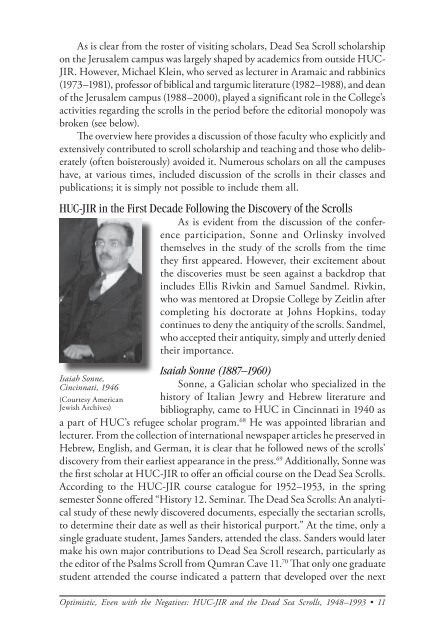The American Jewish Archives Journal, Volume LXI 2009, Number 1
The American Jewish Archives Journal, Volume LXI 2009, Number 1
The American Jewish Archives Journal, Volume LXI 2009, Number 1
Create successful ePaper yourself
Turn your PDF publications into a flip-book with our unique Google optimized e-Paper software.
As is clear from the roster of visiting scholars, Dead Sea Scroll scholarship<br />
on the Jerusalem campus was largely shaped by academics from outside HUC-<br />
JIR. However, Michael Klein, who served as lecturer in Aramaic and rabbinics<br />
(1973–1981), professor of biblical and targumic literature (1982–1988), and dean<br />
of the Jerusalem campus (1988–2000), played a significant role in the College’s<br />
activities regarding the scrolls in the period before the editorial monopoly was<br />
broken (see below).<br />
<strong>The</strong> overview here provides a discussion of those faculty who explicitly and<br />
extensively contributed to scroll scholarship and teaching and those who deliberately<br />
(often boisterously) avoided it. Numerous scholars on all the campuses<br />
have, at various times, included discussion of the scrolls in their classes and<br />
publications; it is simply not possible to include them all.<br />
HUC-JIR in the First Decade Following the Discovery of the Scrolls<br />
As is evident from the discussion of the conference<br />
participation, Sonne and Orlinsky involved<br />
themselves in the study of the scrolls from the time<br />
they first appeared. However, their excitement about<br />
the discoveries must be seen against a backdrop that<br />
includes Ellis Rivkin and Samuel Sandmel. Rivkin,<br />
who was mentored at Dropsie College by Zeitlin after<br />
completing his doctorate at Johns Hopkins, today<br />
continues to deny the antiquity of the scrolls. Sandmel,<br />
who accepted their antiquity, simply and utterly denied<br />
their importance.<br />
Isaiah Sonne,<br />
Cincinnati, 1946<br />
(Courtesy <strong>American</strong><br />
<strong>Jewish</strong> <strong>Archives</strong>)<br />
Isaiah Sonne (1887–1960)<br />
Sonne, a Galician scholar who specialized in the<br />
history of Italian Jewry and Hebrew literature and<br />
bibliography, came to HUC in Cincinnati in 1940 as<br />
a part of HUC’s refugee scholar program. 68 He was appointed librarian and<br />
lecturer. From the collection of international newspaper articles he preserved in<br />
Hebrew, English, and German, it is clear that he followed news of the scrolls’<br />
discovery from their earliest appearance in the press. 69 Additionally, Sonne was<br />
the first scholar at HUC-JIR to offer an official course on the Dead Sea Scrolls.<br />
According to the HUC-JIR course catalogue for 1952–1953, in the spring<br />
semester Sonne offered “History 12. Seminar. <strong>The</strong> Dead Sea Scrolls: An analytical<br />
study of these newly discovered documents, especially the sectarian scrolls,<br />
to determine their date as well as their historical purport.” At the time, only a<br />
single graduate student, James Sanders, attended the class. Sanders would later<br />
make his own major contributions to Dead Sea Scroll research, particularly as<br />
the editor of the Psalms Scroll from Qumran Cave 11. 70 That only one graduate<br />
student attended the course indicated a pattern that developed over the next<br />
Optimistic, Even with the Negatives: HUC-JIR and the Dead Sea Scrolls, 1948–1993 • 11

















